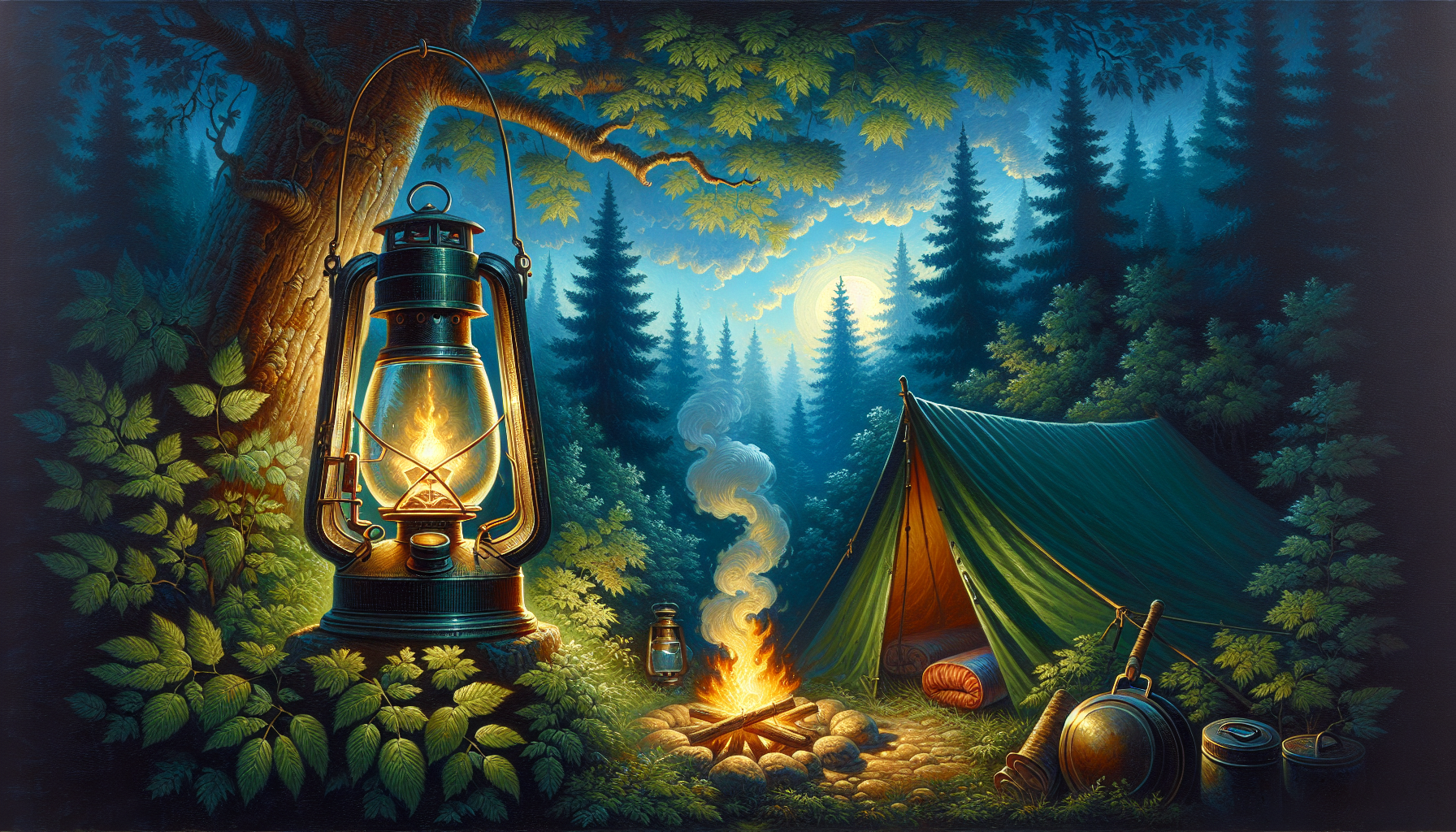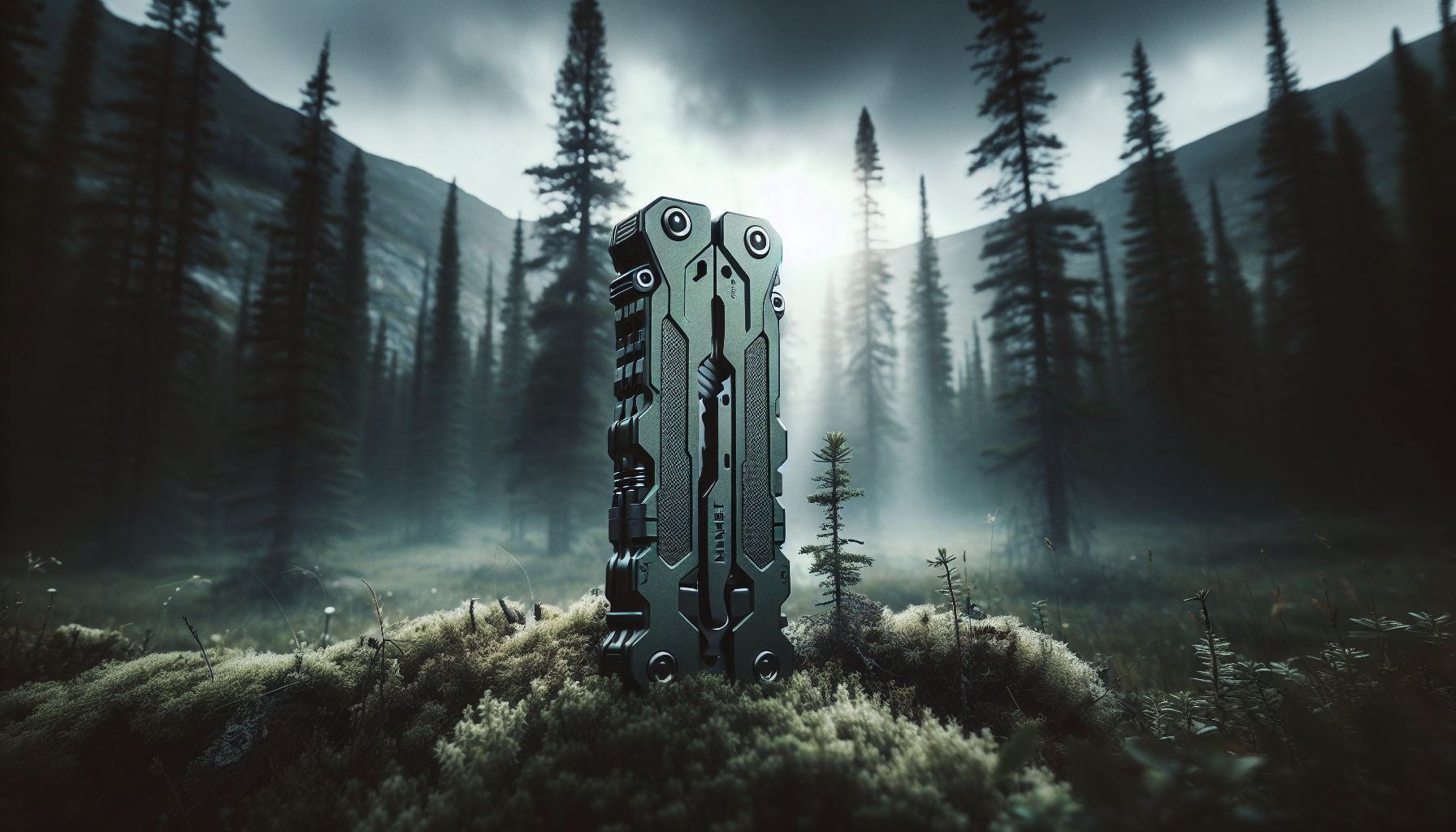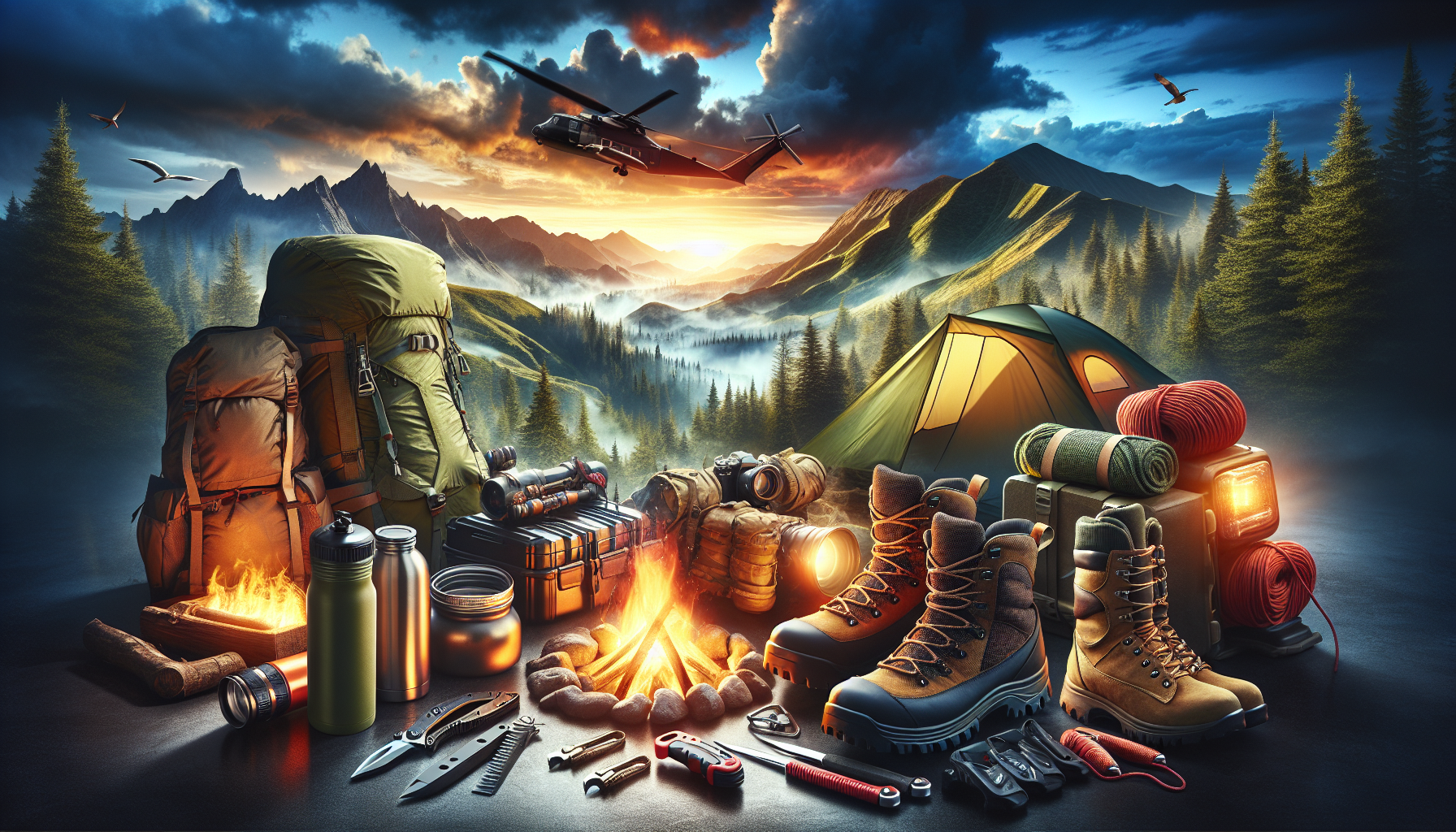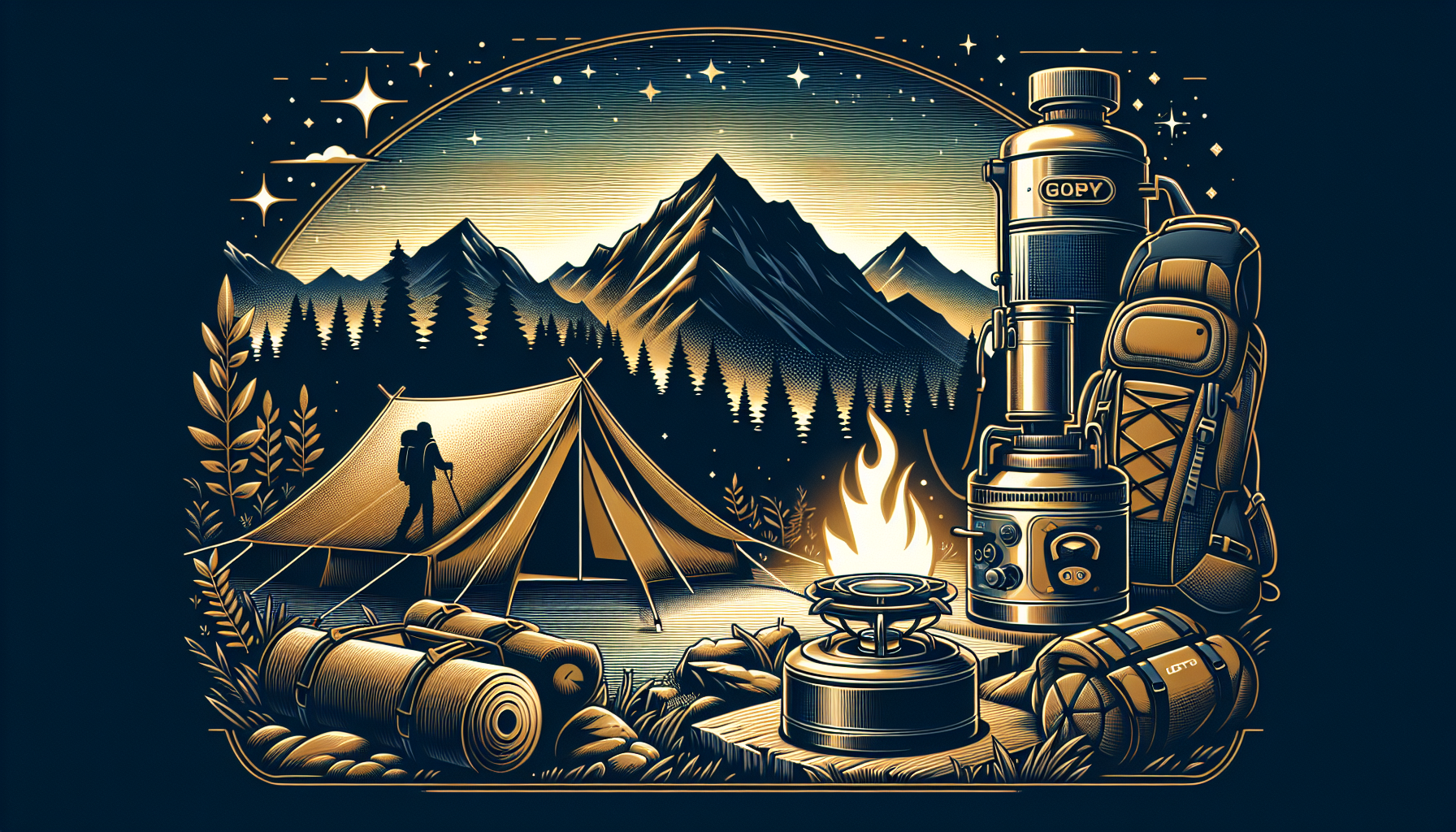Camping Gear 101: A Beginner’s Guide
If you’ve ever been tempted by the allure of the great outdoors, but don’t know where to start, then look no further! “Camping Gear 101: A Beginner’s Guide” is here to help you embark on your outdoor adventure with confidence. Packed with essential tips, recommendations, and must-have gear, this comprehensive guide will ensure that your camping experience is nothing short of amazing. So, whether you’re a seasoned traveler looking to refresh your knowledge or a complete novice ready to embrace the wild, get ready to learn everything you need to know about camping gear in this beginner-friendly guide.
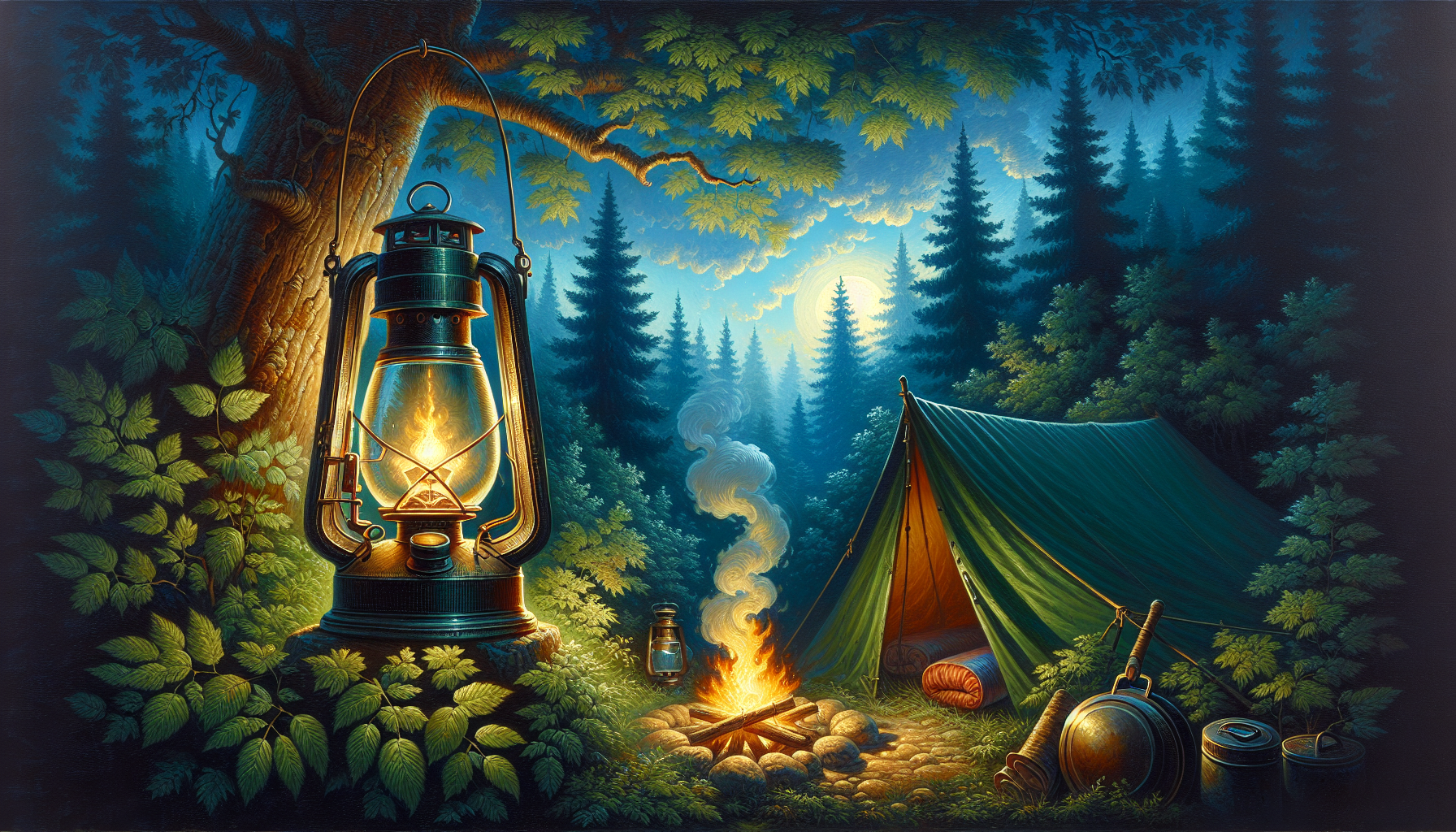
Camping Gear
Choosing the Right Tent
When it comes to camping, choosing the right tent is essential for a comfortable and enjoyable experience. There are a few factors to consider when selecting a tent that will meet your needs.
Consider the number of people
First and foremost, you need to consider the number of people who will be staying in the tent. Tents come in various sizes, from small one-person tents to larger family-sized tents. It’s important to choose a tent that provides enough space for everyone to sleep comfortably and store their gear. If you’re camping alone, a smaller tent may be sufficient, but if you plan on camping with a group or family, a larger tent with multiple rooms or separate sleeping areas may be more suitable.
Choose the right shape
Tents come in different shapes, including dome-shaped, cabin-style, and tunnel tents. Each shape has its own advantages and disadvantages. Dome-shaped tents are known for their stability and ability to withstand strong winds. They are also generally lightweight and easy to set up. Cabin-style tents, on the other hand, offer more vertical space and are ideal for family camping trips where comfort and space are prioritized. Tunnel tents are long and narrow, providing ample sleeping space while minimizing weight. Consider the shape that best suits your needs and preferences.
Consider the seasonality
Another important factor to consider when choosing a tent is the seasonality of your camping trips. Some tents are designed for specific seasons, while others are more versatile and can be used year-round. Three-season tents are the most common and ideal for spring, summer, and fall camping. They are lightweight, breathable, and can handle light rain and wind. If you plan on camping in colder temperatures or more extreme weather conditions, a four-season tent is recommended. These tents are sturdy and insulated, designed to withstand heavy snow loads and strong winds.
Look for high-quality materials
When investing in a tent, it’s important to choose one made from high-quality materials that can withstand the rigors of camping. Look for tents made from durable, waterproof, and breathable materials such as ripstop nylon or polyester. The tent’s seams should also be sealed to prevent leaks. Additionally, consider the quality of the tent’s poles and zippers. Aluminum poles are lightweight yet sturdy, while high-quality zippers ensure easy operation and durability. By choosing a tent made from high-quality materials, you can ensure that it will last for many camping adventures to come.
Sleeping Essentials
A good night’s sleep is crucial when camping, and having the right sleeping essentials can make all the difference in ensuring a comfortable and restful experience.
Sleeping bags
Sleeping bags are a must-have for any camping trip. They provide insulation and warmth, keeping you comfortable throughout the night. When choosing a sleeping bag, consider the temperature rating. Bags with lower temperature ratings are suitable for colder weather, while higher ratings are better for warmer conditions. Additionally, pay attention to the material and insulation type. Synthetic insulation is more affordable and still performs well when wet, while down insulation provides superior warmth and compressibility.
Sleeping pads
Sleeping pads offer comfort and insulation from the cold ground. They come in various types, including closed-cell foam pads, self-inflating pads, and inflatable air mattresses. Closed-cell foam pads are lightweight and durable, but may not provide as much cushioning. Self-inflating pads are a popular choice as they combine the convenience of air mattresses with the insulation of foam pads. Inflatable air mattresses provide the most cushioning and comfort, but take up more space and may require a pump for inflation.
Air mattresses
For those who prioritize comfort above all else, air mattresses are a great option. They provide a more bed-like experience and are ideal for car camping or camping in designated campgrounds with access to electricity. Air mattresses come in different sizes and thicknesses, allowing you to choose the one that suits your preferences. It’s worth investing in a high-quality air mattress that is durable and puncture-resistant to ensure a good night’s sleep.
Camp Cooking Equipment
Eating delicious meals is an integral part of the camping experience, and having the right cooking equipment is essential for preparing tasty and hearty meals in the great outdoors.
Stoves and fuel
A camping stove is a must-have for cooking meals while camping. There are various types of stoves available, including propane stoves, liquid fuel stoves, and wood-burning stoves. Propane stoves are popular due to their convenience and ease of use. They are lightweight, compact, and can be used with disposable propane canisters. Liquid fuel stoves, such as those that use white gas, are more versatile and efficient, making them suitable for longer camping trips. Wood-burning stoves are perfect for those who enjoy cooking over an open fire and want to minimize their reliance on fuel.
When selecting a stove, consider the size, weight, and cooking power. A stove with multiple burners allows for more versatile cooking options, while a smaller and lighter stove is more suitable for backpacking or solo camping trips.
Cookware and utensils
Having the right cookware and utensils makes camp cooking a breeze. Opt for lightweight and durable materials such as stainless steel or titanium. A basic camp cookware set typically includes a pot or pan, a fry pan, and a kettle. Make sure the cookware has sturdy handles for easy handling and a lid to retain heat.
In addition to cookware, bring along essential utensils such as a spatula, tongs, and a knife. A collapsible or compact cutting board is also useful for food preparation. Don’t forget to pack plates, bowls, cups, and cutlery as well.
Food storage
Proper food storage is essential for keeping your meals fresh and preventing unwanted visitors like insects and animals. Invest in quality food storage containers that are airtight and waterproof. Collapsible or stackable containers are great for saving space when packing. Consider bringing cooler bags or coolers with ice packs for perishable food items. Organize your food and keep non-perishable items in separate containers to minimize the risk of contamination.
Lighting and Navigation
Having reliable lighting and navigation tools is essential for a safe and enjoyable camping experience, especially when the sun goes down.
Headlamps and flashlights
A headlamp is an indispensable tool for camping. It leaves your hands free while illuminating your path. Look for a headlamp with adjustable brightness and beam distance. LED headlamps are energy-efficient and provide a bright, focused beam. Carry spare batteries or consider a rechargeable headlamp that can be powered via USB.
Flashlights are also useful for general illumination and can be handy for specific tasks. Choose a compact and durable flashlight with a bright output. Consider a flashlight that is water-resistant or waterproof for added versatility.
Lanterns
Lanterns provide ambient lighting for your campsite, making them perfect for socializing and reading at night. There are various types of camping lanterns, including battery-powered LED lanterns, propane lanterns, and solar-powered lanterns. LED lanterns are energy-efficient and offer long battery life. Propane lanterns provide bright and adjustable lighting but require fuel. Solar-powered lanterns are eco-friendly and charge during the day, providing light at night. Choose a lantern that suits your needs and preferences.
GPS devices and maps
If you plan on exploring remote areas or going on hiking adventures, having a reliable GPS device or a detailed map is crucial for navigation. GPS devices come in various forms, from standalone handheld devices to smartphone apps. They provide accurate position tracking and can help you navigate unfamiliar terrain. Ensure that your GPS device has a long battery life and is equipped with maps of the area you will be exploring.
Maps are a more traditional and reliable navigation tool. Invest in topographic maps that provide detailed information about the terrain, elevation, and key landmarks. Familiarize yourself with map reading skills and bring a compass to complement your navigation efforts.
Compasses
A compass is an essential tool for orienteering and finding your bearings in the wilderness. It is lightweight, compact, and does not require batteries or a signal. Learn the basics of using a compass, such as taking a bearing and following a map. Carry a compass with you at all times and ensure it is of good quality with clear markings.
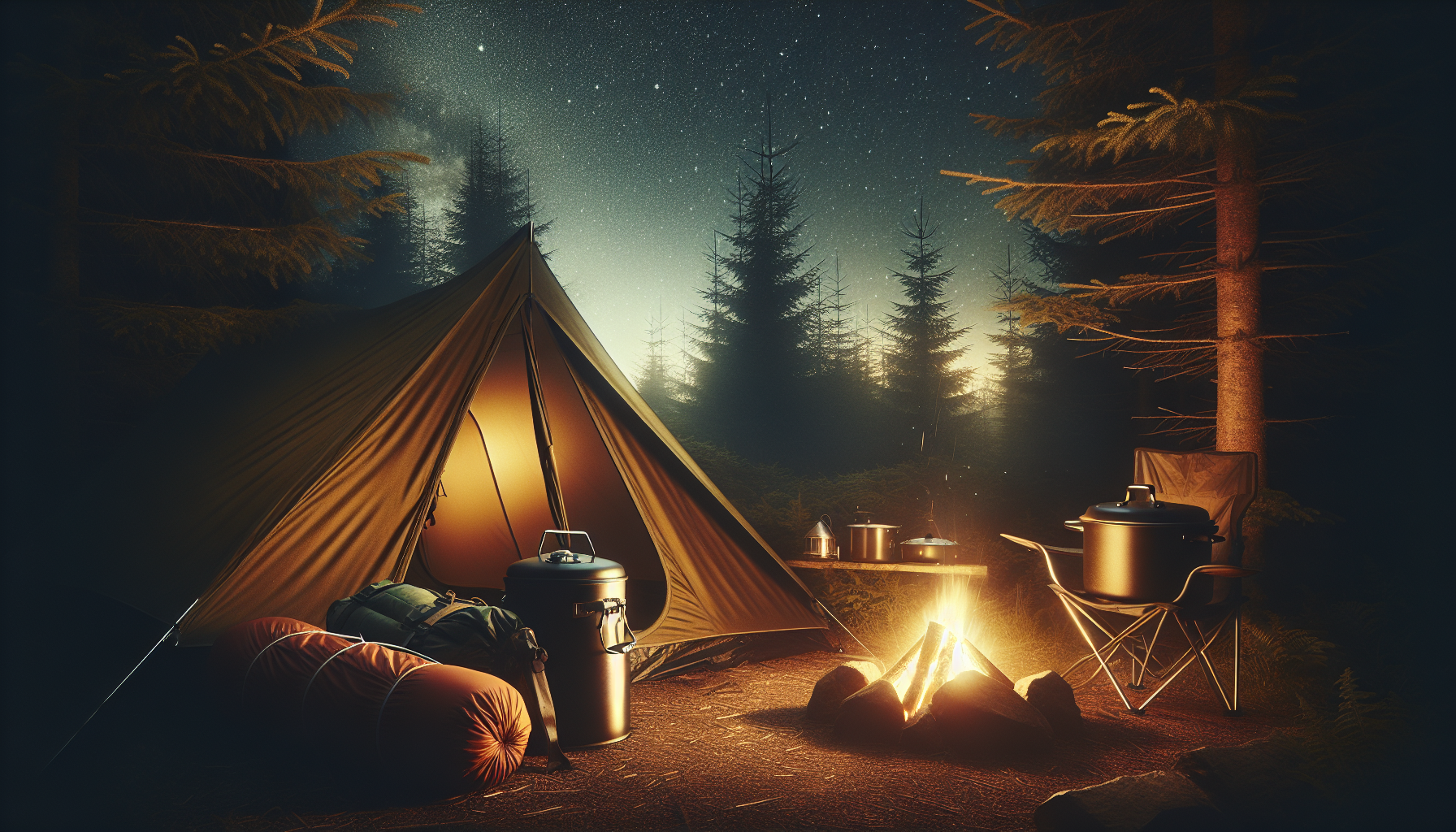
Essential Clothing and Footwear
Having the right clothing and footwear is essential for staying comfortable, protected, and prepared for changing weather conditions while camping.
Layering system
The key to dressing for outdoor activities is layering. A layering system involves wearing multiple thin layers that can be added or removed as needed to regulate body temperature. The layers typically consist of a base layer, mid-layer, and outer layer.
The base layer is in direct contact with your skin and should be made from moisture-wicking material to keep you dry. Merino wool or synthetic fabrics are popular choices.
The mid-layer provides insulation and should be warm and breathable. Fleece jackets or down vests are commonly used mid-layers.
The outer layer, also known as a shell, protects you from wind, rain, and snow. It should be waterproof and breathable. Look for jackets made from durable materials like Gore-Tex.
Rain gear
Rain can be unpredictable, so it’s important to pack appropriate rain gear to stay dry and comfortable. Invest in a waterproof jacket and pants made from a reliable material like Gore-Tex. Look for features like taped seams and adjustable hoods to keep you protected from the elements. Consider packable rain gear that can easily fit into your backpack.
Hiking boots
Having a pair of comfortable and sturdy hiking boots is crucial for exploring the great outdoors. Look for boots that provide good ankle support, have a waterproof and breathable membrane, and offer a durable outsole for traction. Try on boots with hiking socks to ensure a proper fit.
Wool socks
Don’t underestimate the importance of good socks when camping. Wool socks are a popular choice as they provide insulation, cushioning, and moisture-wicking properties. Merino wool socks are particularly comfortable and can keep your feet warm even when wet. Pack enough pairs of socks for your camping trip to ensure you stay comfortable and blister-free.
Hydration and Water Purification
Staying hydrated is essential when camping, especially during outdoor activities. Having the right equipment for water storage and purification is crucial for ensuring a safe and reliable water source.
Water bottles and hydration packs
Invest in durable and reusable water bottles that are easy to carry and have a sufficient capacity. Look for bottles made from BPA-free materials. Consider insulated water bottles to keep your water cool in hot weather.
Hydration packs are a convenient option for hands-free drinking on the go. These packs include a backpack with a built-in water reservoir and a tube for drinking. Look for packs with a large reservoir capacity and adjustable straps for a comfortable fit.
Water filters and purifiers
If you plan on camping in areas with natural water sources like rivers or lakes, a water filter or purifier is essential for ensuring safe drinking water. Water filters remove bacteria, protozoa, and sediment from the water, while purifiers can also eliminate viruses.
There are various types of water filters and purifiers available, including pump filters, gravity filters, and water bottle filters. Consider the volume of water you need to filter and the ease of use when selecting a filter or purifier.
Water treatment tablets
Water treatment tablets are a compact and lightweight option for water purification. These tablets contain chemicals that kill bacteria, viruses, and other harmful microorganisms. Follow the instructions on the packaging to effectively treat the water. It’s important to carry enough tablets for the duration of your camping trip.
First Aid and Safety
Being prepared for emergencies and having the necessary first aid supplies is essential when camping in remote locations with limited access to medical facilities.
First aid kits
A well-stocked first aid kit is a camping essential. It should include basic supplies such as band-aids, adhesive tape, antiseptic wipes, gauze pads, adhesive bandages, tweezers, scissors, and pain relievers. Consider adding items specific to your needs, such as insect repellent, allergy medication, or a snakebite kit. Familiarize yourself with the contents of your first aid kit and how to use them effectively.
Emergency shelter
In case of unexpected weather conditions or a need to shelter overnight, having an emergency shelter is crucial. A lightweight and compact emergency bivy or shelter can provide protection from the elements. Look for shelters made from durable materials that are easy to set up and can withstand wind and rain. Carry emergency blankets or space blankets for additional warmth and insulation.
Fire safety
Fire is an essential part of camping, but it’s important to practice fire safety to prevent accidents and minimize the risk of wildfires. Ensure you camp in designated fire pits and follow any fire restrictions in the area. Always have a fire extinguisher or a bucket of water nearby to extinguish the fire. Familiarize yourself with the proper techniques for building and extinguishing a campfire. Remember to never leave a fire unattended and fully extinguish it before leaving your campsite.
Campsite Comfort and Organization
Creating a comfortable and organized campsite enhances the overall camping experience and allows you to relax and enjoy your surroundings.
Camp chairs and tables
Having comfortable seating options is essential, especially if you plan on spending time at your campsite. Look for lightweight and collapsible camp chairs that are easy to transport and set up. Consider chairs with built-in cup holders or side pockets for added convenience.
A camp table provides a convenient surface for meal preparation or a place to place belongings. Look for tables that are lightweight, compact, and easy to assemble.
Campsite organization
Keeping your campsite organized is essential for a stress-free camping experience. Invest in storage solutions such as camping bins or duffel bags to keep your gear neatly organized and protected from the elements. Use tarps or ground covers to create designated areas for cooking, relaxing, and sleeping. Hang a clothesline or bring portable drying racks to dry wet clothes or towels.
Tarps and hammocks
Tarps are versatile camping essentials that can provide additional shelter, protect your gear from rain, or create extra space for cooking or lounging. Look for lightweight and waterproof tarps that can be easily carried and set up.
Hammocks are a luxurious addition to any campsite, providing a comfortable spot for relaxation and enjoying the outdoors. Look for hammocks that are durable and can support your weight. Choose a hammock with a bug net if you plan on camping in areas with high mosquito activity.
Choosing the Right Backpack
A comfortable and well-fitting backpack is crucial for carrying all your camping gear and essentials. When choosing a backpack, consider the following factors:
Consider the capacity
The backpack’s capacity should align with the length and duration of your camping trip and the amount of gear you plan to carry. Backpacks generally come in sizes such as 30 liters, 50 liters, or 70 liters. A smaller capacity is suitable for overnight or weekend trips, while larger capacities are ideal for extended trips or winter camping when bulkier gear is required. Try on different sizes and ensure the backpack fits comfortably on your shoulders and hips.
Choose the right type
Backpacks come in various types, including internal frame, external frame, and frameless. Internal frame backpacks are the most common and versatile, offering better load distribution and stability. External frame backpacks are less common but provide increased ventilation and support for heavier loads. Frameless backpacks are lightweight and compact, making them suitable for ultralight backpacking. Choose a type that suits your camping style and load requirements.
Adjustability and fit
A properly fitted backpack is essential for comfort and preventing strain or injuries. Look for backpacks with adjustable shoulder straps, hip belts, and load lifters. The hip belt should sit comfortably on your hips, transferring the weight of the pack to your lower body. Adjust the shoulder straps to ensure a snug fit without causing discomfort or restricting movement.
Consider the features
Backpacks come with various features that enhance convenience and organization. Look for backpacks with multiple compartments, pockets, and attachment points for gear such as tents or trekking poles. Consider features like a hydration bladder sleeve, a rain cover, or compression straps. Choose a backpack that offers the features you prioritize for your camping needs.
Essential Camping Accessories
Besides the essential gear mentioned above, there are a few additional camping accessories that can enhance your camping experience and make life outdoors more enjoyable.
Multitool
A multitool is a handy tool that combines various functions into a single device. It typically includes pliers, a knife, screwdrivers, a can opener, and more. A multitool is useful for various campsite tasks, from repairing gear to preparing meals. Look for a multitool with a compact design and high-quality construction.
Duct tape
Duct tape is a versatile and practical item to have in your camping kit. It can be used for emergency gear repairs, securing tarps, or creating makeshift solutions. Wrap a small amount of duct tape around a lighter or pencil to save space and avoid carrying a bulky roll.
Firestarter
Having a reliable firestarter can make starting a campfire quick and easy. There are various firestarter options available, including waterproof matches, flint and steel, or fire starters made of wax-infused cotton or magnesium. Choose a firestarter that suits your preference and ensure it is stored in a waterproof container.
Camp ax
A camp ax or hatchet can be useful for chopping firewood, clearing debris, or hammering tent stakes. Look for a compact and lightweight option that fits comfortably in your backpack. Keep safety in mind when using an ax and learn proper techniques for chopping and splitting wood.
Camping Gear 101: Your Complete Beginner’s Guide Camping is a fantastic way to connect with nature, enjoy outdoor activities, and create lasting memories. To ensure a successful camping adventure, it’s important to have the right gear on hand. From choosing the perfect tent to packing essential camping accessories, this comprehensive guide will help you navigate the world of camping gear and make informed choices for an enjoyable outdoor experience.
Choosing the Right Tent Your tent will serve as your home away from home while camping, so it’s crucial to find one that meets your needs. When selecting a tent, consider the number of people who will be staying in it. Choose a tent that provides ample space for sleeping and storing gear. The shape of the tent is also important. Dome-shaped tents offer stability, while cabin-style tents provide more vertical space. Consider the seasonality of your camping trips and select a tent designed for the appropriate seasons. Finally, look for a tent made from high-quality materials that are durable and waterproof.
Sleeping Essentials A good night’s sleep is essential for an enjoyable camping experience. A sleeping bag is a must-have item, and you should consider the temperature rating, material, and insulation type when selecting one. A sleeping pad or air mattress provides insulation and cushioning from the ground, offering added comfort. Choose a sleeping pad that suits your preferences, whether it’s closed-cell foam, self-inflatable, or inflatable.
Camp Cooking Equipment Eating delicious meals is an integral part of camping, and having the right cooking equipment is essential. A camping stove is a must-have item, and you should consider the type of stove and the fuel it requires. Cookware and utensils are also important for preparing meals. Look for lightweight and durable options that are easy to clean. Proper food storage is crucial for keeping your meals fresh and preventing unwanted visitors like insects or animals. Invest in quality food storage containers that are airtight and waterproof.
Lighting and Navigation When the sun goes down, having reliable lighting and navigation tools is essential. A headlamp provides hands-free lighting, making it easy to navigate in the dark. Lanterns offer ambient lighting for the campsite, and there are various options available, including battery-powered LED lanterns and solar-powered lanterns. If you plan on exploring remote areas or going on hiking adventures, having a reliable GPS device or a detailed map is crucial for navigation. Consider a compass as a backup for orienteering.
Essential Clothing and Footwear Proper clothing and footwear are essential for comfort and protection while camping. The layering system is a key concept in dressing for outdoor activities. Choose clothing made from moisture-wicking materials, and layer your clothing to regulate body temperature. Rain gear is essential for staying dry during unexpected rain showers. Invest in waterproof jackets and pants. A reliable pair of hiking boots with good ankle support, waterproofing, and durable outsoles is crucial. Don’t forget to pack wool socks for added comfort and insulation.
Hydration and Water Purification Staying hydrated is essential, and having the right equipment for water storage and purification is crucial. Invest in durable and reusable water bottles or hydration packs. Water filters or purifiers are essential if you plan on drinking from natural water sources. Water treatment tablets are lightweight and convenient for water purification.
First Aid and Safety Being prepared for emergencies is essential when camping in remote locations. A well-stocked first aid kit is a must-have item and should include basic supplies such as band-aids, adhesive tape, and pain relievers. An emergency shelter provides protection in case of unexpected weather conditions. Practice fire safety by following fire restrictions in the area and having a fire extinguisher or water source nearby.
Campsite Comfort and Organization Creating a comfortable and organized campsite enhances your camping experience. Camp chairs and tables provide comfortable seating and surfaces for meal preparation. Invest in storage solutions like camping bins or duffel bags to keep your gear organized. Use tarps for additional shelter or to create designated areas. Hammocks provide a comfortable spot for relaxation.
Choosing the Right Backpack A comfortable and well-fitting backpack is crucial for carrying all your camping gear. Consider the capacity of the backpack and choose one that aligns with the length and duration of your camping trip. Select the right type of backpack, whether it’s internal frame, external frame, or frameless, based on your needs. Ensure the backpack is adjustable and fits comfortably on your shoulders and hips. Consider the features of the backpack, such as compartments, attachments, or hydration bladder sleeves.
Essential Camping Accessories In addition to the essential gear mentioned, there are a few additional camping accessories that can enhance your camping experience. A multitool combines various functions into a single tool, making it handy for various tasks. Duct tape is versatile and can be used for emergency gear repairs. Firestarters make starting a campfire quick and easy. A camp ax is useful for chopping firewood and clearing debris.
With this comprehensive guide to camping gear, you’ll be well-prepared for your next outdoor adventure. Choose the right gear based on your needs and preferences, and don’t forget to check the weather forecast and research the camping area’s rules and restrictions. Remember to pack responsibly and leave no trace, so future campers can enjoy nature’s beauty. Happy camping!

